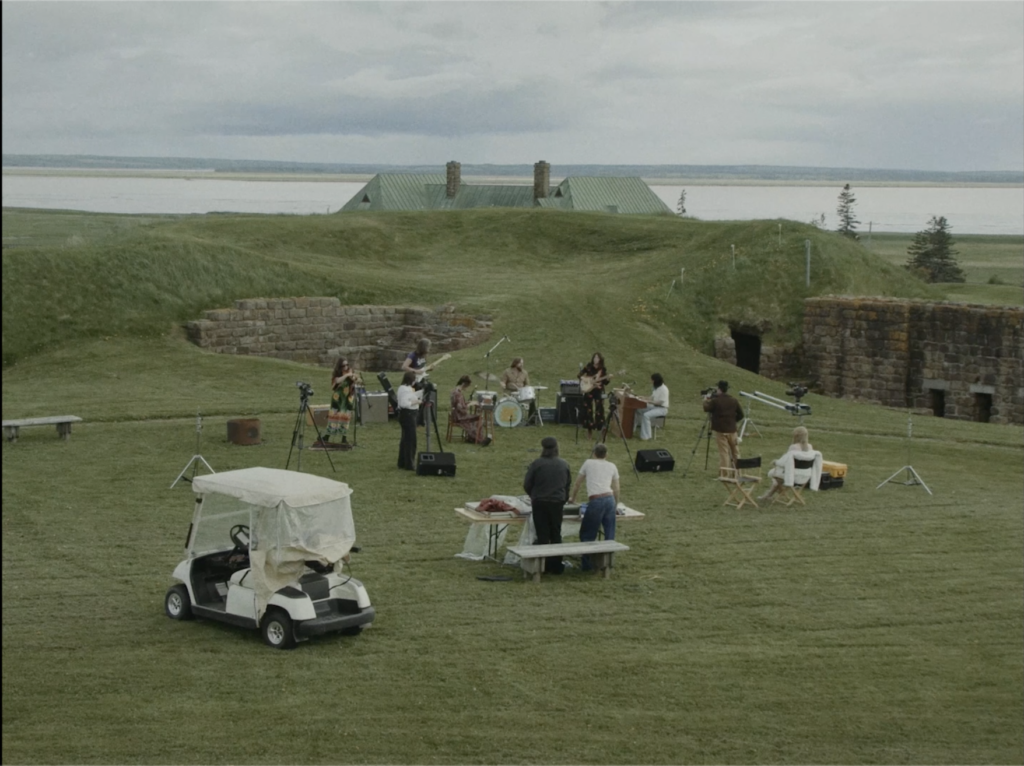
Extrait du film «L'Empremier live at Beaubassin (1970)»
L’Empremier live at Beaubassin (1970)
Rémi BELLIVEAU (Memramcook)
Exposition, Terminé(e)
Du 12 septembre 2024 au 15 décembre 2024
Salle principale
Vernisage le 12 septembre 2024, 17:00
L’Empremier live at Beaubassin (1970) est une œuvre vidéo pastiche du film Live at Pompeii (1972, 1974) d’Adrian Maben, où l’on voit le groupe mythique Pink Floyd jouer dans un amphithéâtre romain vide. À Beaubassin, les ruines du Fort Beauséjour – situées à la frontière entre le Nouveau-Brunswick et la Nouvelle-Écosse – servent d’amphithéâtre dans lequel les esprits du passé (ceux d’acadien·ne·s, condamné·e·s ici, en 1755, à la déportation et l’errance) sont convoqués comme spectateur·trice·s fantomatiques.
Adoptant le décor de l’été 1970, Live at Beaubassin met en scène un·e chansonnier·ère acadien·ne fictive – Joan Dularge – préoccupé·e par l’actualité LGBT[Q2IA+] au lendemain des Stonewall riots (28 juin 1969) et motivé·e par sa condition de personne nouvellement trans-out. Aux prises avec ces enjeux et ceux de l’Acadie, Joan et son groupe doivent répondre à des questions intemporelles telles que : « Jouez-vous de la musique acadienne ? » et « Est-ce que l’acadienneté est une forme de queerness ? ».
L’artiste aimerait remercier le Conseil des arts du Canada, MOMENTA Biennale de l’image et la Fondation RBC pour leur soutien financier.
L’ARTISTE
Sa démarche artistique s’ancre dans sa culture d’appartenance (acadienne) souvent prise entre son passé (son histoire, son folklore, ses récits, ses coutumes) et son présent (sa diaspora, ses luttes sociales, ses dialectes, sa culture populaire). Cet héritage complexe, relevant tant d’un passé (lointain ou récent), que du présent, voire du futur, est la matière première de son travail.
Iel cherche à problématiser la culture acadienne en la confrontant à ses multiples contradictions liées à son statut hybride, qui oscille entre folklorique et contemporain. Iel explore celles-ci à travers une démarche interdisciplinaire qui brouille les frontières entre la posture créatrice de l’artiste, parfois musicien·ne, et celle, plus institutionnelle, de l’historien·ne-archiviste, parfois musicologue.
Ses projets ont pour point de départ les archives et prennent souvent la forme de collections dans lesquelles des artéfacts historiques, soit acquis, empruntés ou façonnés, partagent un statut ambigu avec les œuvres qu’iel crée.
Rémi Belliveau est un·e artiste et musicien·ne interdisciplinaire acadien·ne originaire de Belliveau-Village (vallée de Memramcook, Nouveau-Brunswick), un hameau acadien situé sur Mi’kma’ki, le territoire ancestral non cédé du peuple Mi’kmaq.
Son travail artistique s’attache à déconstruire et reprogrammer les fondements, les structures et les imaginaires de la culture acadienne à laquelle iel appartient, dans le but de cultiver des capacités d’(auto)analyse et de sens critique.
Récemment, iel a été deux fois en lice au Prix Sobey pour les arts (finaliste Atlantique en 2021, liste préliminaire Atlantique en 2024), lauréat·e du Prix Claudine et Stephen Bronfman (2022), lauréat·e des Ateliers Montréalais de la Fonderie Darling (2023-2026) et finaliste au Prix en art actuel du Musée national des beaux-arts du Québec (2025).
L’Empremier live at Beaubassin (1970)
L’Empremier Live at Beaubassin (1970) is a video that parodies Adrian Maben’s film, Live at Pompeii (1972, 1974), where the legendary band Pink Floyd is seen performing in an empty Roman amphitheatre. In Beaubassin, the ruins of Fort Beauséjour – located on the border between New Brunswick and Nova Scotia – serve as an amphitheatre in which the spirits of the past (those of Acadians condemned to deportation and wandering here in 1755) are summoned as ghostly spectators.
Set against the backdrop of the summer of 1970, Live at Beaubassin features a fictional Acadian singer-songwriter—Joan Dularge—who is deeply concerned with LGBTQ2IA+ issues in the wake of the Stonewall Riots (June 28, 1969) and driven by their experience of newly coming out as trans. Grappling with these issues and those of Acadia, Joan and their band must confront timeless questions such as « Do you play Acadian music? » and is being Acadian a form of queerness?
The artist would like to thank the Canada Council for the Arts, MOMENTA Biennale de l’Image and the RBC Foundation for their financial support.
THE ARTIST
Their artistic approach is rooted in the culture to which they belong (Acadian), often entangled between its past (its history, folklore, stories and customs) and its present (its diaspora, social struggles, dialects and popular culture). This complex heritage, encompassing both the distant and recent past, the present and even the future, serves as the raw material for their work.
They seek to problematize Acadian culture by confronting it with the multiple contradictions linked to its hybrid status, which vacillates between the folkloric and the contemporary. They explore these notions through an interdisciplinary approach that obscures the boundaries between the creative posture of the artist, a musician at times, and the more institutional posture of the historian-archivist, a musicologist at others.
Their projects often start with archives and typically take the form of collections where historical artifacts—whether acquired, borrowed, or crafted—share an ambiguous status with the works they create.
Rémi Belliveau is an Acadian trans non-binary interdisciplinary artist and musician hailing from Memramcook, New Brunswick, a village located in Mi’kma’ki, the traditional unceded territory of the Mi’kmaq people.
Their work attempts to deconstruct and reprogram the foundational, structural, and imaginary principles of the Acadian culture to which they belong in the hopes of cultivating capacities for (self) analysis and critical thinking.
Recently, they were twice shortlisted for the Sobey Art Award (Atlantic finalist in 2021, Atlantic longlist in 2024), awarded the Claudine and Stephen Bronfman Fellowship (2022), selected as a recipient of the Montréal live-in studios at Fonderie Darling (2023–2026) and a finalist for the Contemporary Art Award at the Musée National des Beaux-Arts du Québec (2025).
















